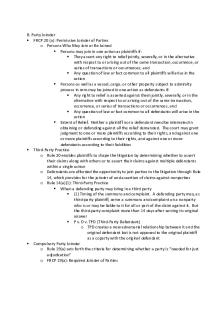Week nine - NOTES PDF

| Title | Week nine - NOTES |
|---|---|
| Course | Developmentally Appropriate Child Guidance |
| Institution | St. Clair College of Applied Arts and Technology |
| Pages | 2 |
| File Size | 86 KB |
| File Type | |
| Total Downloads | 77 |
| Total Views | 161 |
Summary
NOTES...
Description
WEEK 9 MISTAKEN BEHAVIOUR LEVELS OF MISTAKEN BEHAVIOUR ■ The three levels of mistaken behavior ■ Level One, experimentation mistaken behavior. ■ Level Two, socially influenced mistaken behavior. ■ Level Three, strong needs mistaken behavior. LEVEL ONE: EXPERIMENTATION Two Motives Here: ■ Involvement: Situation evolves causing it to get out of hand ■ We see this with children daily ■ Start off amicable and then gets out of hand ■ Curiosity: When the child is testing the boundaries they want to see what happens ■ Children of all ages start to do this level, they want to see what will happen and what you will do ■ We need to establish the boundaries ■ This is developmentally aged as well, a toddler will test different boundaries than a kindergartener ■ Examples: ■ Children fighting over a toy (I) ■ The child looks at you, throws something on the floor to see your reaction (C) LEVEL TWO: SOCIALLY INFLUENCED ■ Family ■ Adults around them ■ Educators and classmates ■ Friends ■ Movies, TV, video games, etc. ■ Example? LEVEL THREE: STRONG UNMET NEEDS ■ Not getting their needs met ■ Environment ■ Traumatic Event ■ Eg: divorce, if we see a change in their behaviour that typically werent there ■ If we dont know if something is happening a home we shoud inquiry in a certain way ■ Child with diverse needs ■ Example? Review from first lecture: behaviour is communication, 5 domains of self regulation - Iceberg analogy
WHAT HAPPENS WHEN IT IS A PROBLEM THAT IMPACTS THE GROUP? ■ 1) What is this called? ■ 2) What kinds of problems are discussed at this time? ■ 3) Where to meet and what happens there?
PREVENTING CONFLICTS What have you learned in this class to do when working with children? ■ Let’s try breakout groups!!! CONFLICT RESOLUTION FOR OLDER CHILDREN 1. What is peer mediation? - Kids helping other kids solve their problems - This can be more effective than if an adult plays that role - Much more receptive to a peer mediator in different situations rather than with an adult - When using the 6 steps, children pick it up and they are able to play that role for one another - Sparks the need of upstandards, its not innate in school agers to get involved - They think if someone is picking on them then at least they arent picking on me 2. Who and how does it help? EXPLAIN WHAT A QUICK MEDIATION IS: ■ Reminder… What is differentiated instruction and can it help reduce conflicts in your classroom and support children’s social and emotional health? ■ Sometimes they dont need to go through the 6 steps, we can use a quick version ■ Doing the steps we feel are necessary to solve the problem quickly WHAT IS AN ENVIRONMENT THAT ENCOURAGES PROBLEM SOLVING? - Before you speak, think - Is it true? Is it helpful? Is it inspiring? Is it necessary? Is it kind? /// EARLY CHILDHOOD EDUCATORS NEVER STOP LEARNING… ■ When educators have a trusting relationship with children, they can encourage them to take chances and show initiative in an environment where they feel emotionally safe and therefore comfortable enough to take appropriate risks. ■ Responsible educators guide children with strategies that help them manage their emotions, understand the emotions of others, become more confident, and foster relationships with their peers...
Similar Free PDFs

Week nine - NOTES
- 3 Pages

Week nine - NOTES
- 2 Pages

Week Nine - Lecture notes 9
- 6 Pages

Week Nine - Kristen Fryer
- 3 Pages

Week Nine Feeney Warrants
- 7 Pages

Nine Bottles-Tech. Memo
- 5 Pages

Chapter Nine Reading
- 17 Pages

Crucigrama Filosofía Anexo Nine
- 2 Pages

The Nine Darśanas
- 7 Pages

Lectures one to nine
- 15 Pages

The thirty-nine steps
- 6 Pages

Chapter Nine Quiz - Della
- 2 Pages

Week 4 - Week 4 notes
- 4 Pages

Otros ambientes 9 twenty nine
- 3 Pages
Popular Institutions
- Tinajero National High School - Annex
- Politeknik Caltex Riau
- Yokohama City University
- SGT University
- University of Al-Qadisiyah
- Divine Word College of Vigan
- Techniek College Rotterdam
- Universidade de Santiago
- Universiti Teknologi MARA Cawangan Johor Kampus Pasir Gudang
- Poltekkes Kemenkes Yogyakarta
- Baguio City National High School
- Colegio san marcos
- preparatoria uno
- Centro de Bachillerato Tecnológico Industrial y de Servicios No. 107
- Dalian Maritime University
- Quang Trung Secondary School
- Colegio Tecnológico en Informática
- Corporación Regional de Educación Superior
- Grupo CEDVA
- Dar Al Uloom University
- Centro de Estudios Preuniversitarios de la Universidad Nacional de Ingeniería
- 上智大学
- Aakash International School, Nuna Majara
- San Felipe Neri Catholic School
- Kang Chiao International School - New Taipei City
- Misamis Occidental National High School
- Institución Educativa Escuela Normal Juan Ladrilleros
- Kolehiyo ng Pantukan
- Batanes State College
- Instituto Continental
- Sekolah Menengah Kejuruan Kesehatan Kaltara (Tarakan)
- Colegio de La Inmaculada Concepcion - Cebu

